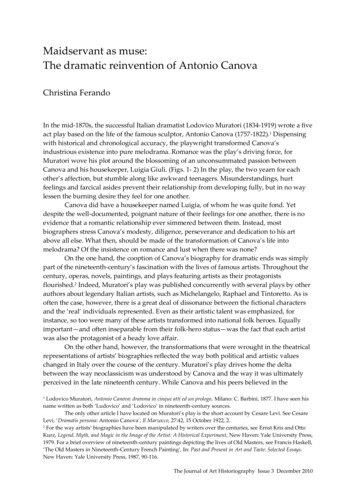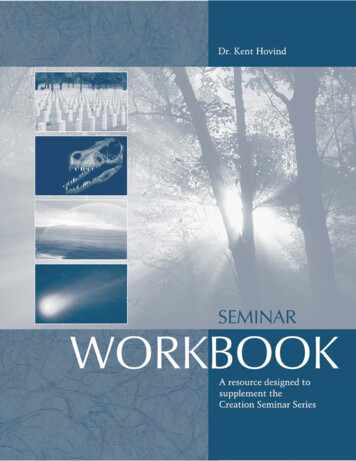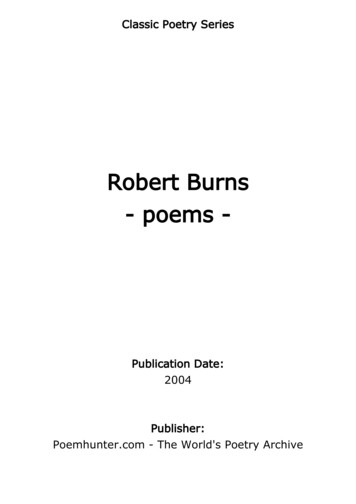
Transcription
Maidservant as muse:The dramatic reinvention of Antonio CanovaChristina FerandoIn the mid-1870s, the successful Italian dramatist Lodovico Muratori (1834-1919) wrote a fiveact play based on the life of the famous sculptor, Antonio Canova (1757-1822).1 Dispensingwith historical and chronological accuracy, the playwright transformed Canova’sindustrious existence into pure melodrama. Romance was the play’s driving force, forMuratori wove his plot around the blossoming of an unconsummated passion betweenCanova and his housekeeper, Luigia Giuli. (Figs. 1- 2) In the play, the two yearn for eachother’s affection, but stumble along like awkward teenagers. Misunderstandings, hurtfeelings and farcical asides prevent their relationship from developing fully, but in no waylessen the burning desire they feel for one another.Canova did have a housekeeper named Luigia, of whom he was quite fond. Yetdespite the well-documented, poignant nature of their feelings for one another, there is noevidence that a romantic relationship ever simmered between them. Instead, mostbiographers stress Canova’s modesty, diligence, perseverance and dedication to his artabove all else. What then, should be made of the transformation of Canova’s life intomelodrama? Of the insistence on romance and lust when there was none?On the one hand, the cooption of Canova’s biography for dramatic ends was simplypart of the nineteenth-century’s fascination with the lives of famous artists. Throughout thecentury, operas, novels, paintings, and plays featuring artists as their protagonistsflourished.2 Indeed, Muratori’s play was published concurrently with several plays by otherauthors about legendary Italian artists, such as Michelangelo, Raphael and Tintoretto. As isoften the case, however, there is a great deal of dissonance between the fictional charactersand the ‘real’ individuals represented. Even as their artistic talent was emphasized, forinstance, so too were many of these artists transformed into national folk heroes. Equallyimportant—and often inseparable from their folk-hero status—was the fact that each artistwas also the protagonist of a heady love affair.On the other hand, however, the transformations that were wrought in the theatricalrepresentations of artists’ biographies reflected the way both political and artistic valueschanged in Italy over the course of the century. Muratori’s play drives home the deltabetween the way neoclassicism was understood by Canova and the way it was ultimatelyperceived in the late nineteenth century. While Canova and his peers believed in theLodovico Muratori, Antonio Canova: dramma in cinque atti ed un prologo, Milano: C. Barbini, 1877. I have seen hisname written as both ‘Ludovico’ and ‘Lodovico’ in nineteenth-century sources.The only other article I have located on Muratori’s play is the short account by Cesare Levi. See CesareLevi, ‘Dramatis persona: Antonio Canova’, Il Marzocco, 27:42, 15 October 1922, 2.2 For the way artists’ biographies have been manipulated by writers over the centuries, see Ernst Kris and OttoKurz, Legend, Myth, and Magic in the Image of the Artist: A Historical Experiment, New Haven: Yale University Press,1979. For a brief overview of nineteenth-century paintings depicting the lives of Old Masters, see Francis Haskell,‘The Old Masters in Nineteenth-Century French Painting’, In: Past and Present in Art and Taste: Selected Essays.New Haven: Yale University Press, 1987, 90-116.1The Journal of Art Historiography Issue 3 December 2010
Christina FerandoMaidservant as muse: The dramatic reinvention of Antonio Canovagenerative power of imitation and the antique, by the end of the century neoclassicism wasviewed as the stultifying repetition of antiquity. 3 Muratori’s insistence on theunconsummated passion between Canova and Luigia, therefore, is really a means by whichthe playwright establishes love as the creative inspiration behind artistic production. Luigiabecomes not only Canova’s paramour, but also his muse. This transformation connectsCanova to other great artist-lovers, certainly. More importantly, it contains an implicitcritique of neoclassicism itself. Artistic inspiration is disengaged from imitation and the roteact of copying and located instead in the very personal and subjective emotions of the artist.In order to maintain the validity of an otherwise outmoded style, by the late nineteenthcentury neoclassicism and its suffocating image of repetition were necessarily recast to fitthe political, sociological and artistic developments of the time.Fig. 1 Luigia Giuli (ca. 1746-1811), Antonio Canova, 1793.Oil on canvas, 28 x 23 cm. Photo courtesy of PandolfiniCasa D'Aste, Florence, Italy.Fig. 2 Antonio Canova (1757-1822), Luigia Giuli, 1799.Oil on canvas, 74 x 61 cm. Possagno, Italy: MuseoGipsoteca Antonio Canova***That Canova was the subject of a popular Italian drama is not surprising, given his stature asboth a diplomat and the greatest sculptor in Europe during the early nineteenth century. InItaly in particular the memory of Canova’s work retained great allure. Not only were hissculptures incessantly reproduced by sculptors seeking to capitalize on his fame,4 but he wasalso the subject of innumerable posthumous biographies that contained ample material forAs Hugh Honour points out, the very term ‘neoclassicism’ is a critique in and of itself. Although neoclassicalartists themselves had referred to their work as the ‘true style’, late nineteenth-century critics applied the term‘neoclassicism’ to the art of the mid-to-late eighteenth century and early nineteenth century retroactively. SeeHugh Honour, Neo-Classicism, Harmondsworth and New York: Penguin Books, 1977, 14.4 Hugh Honour, ‘Canova's Studio Practice II: 1791-1822’, The Burlington Magazine, 114:829, April 1972, 226 and229.32
Christina FerandoMaidservant as muse: The dramatic reinvention of Antonio Canovadramatic adaptations.5 Published in the years immediately following Canova’s death bytrusted friends and colleagues, these biographies celebrated both the artist’s fame, as well asthe authors’ first-hand knowledge of his life.In addition, throughout the nineteenth century, slow transformations in the theatreand in the political construction of Italy as a nation-state promoted the interconnectionbetween the stage and the life of the artist.6 Although many historical dramas at midcenturyhad been influenced by translations of French melodramas, particularly those of VictorHugo and Alexander Dumas, by the 1850s, as the nascent unification movement gainedpower, Italian theatre began to seek out intrinsically Italian subject matter. By the late 1850sand 1860s, several Italian theatre companies pledged to perform works written in Italian—not local dialects—by Italian authors, with Italian themes as their subjects.7 In fact, the newItalian government encouraged such plays by actively promoting competitions andawarding monetary prizes to playwrights who best succeeded in creating ‘Italian’ dramas.8Not surprisingly, as the theatre historian Marvin Carlson points out, at times these playsdepicted Italy’s greatest artists as their protagonists, in order to increase the plays’ ‚artistic’merit*s .‛9The editor Barbini’s publication of Muratori’s play on Canova in 1877 was thereforenot an isolated development, for between 1873 and 1875 the publishing house also circulatedplays about Michelangelo, Raphael, Tintoretto, and Pietro da Cortona, transforming theseartists into popular romantic figures and contemporary folk heroes for the new nation.10Numerous biographies of Canova were published throughout the nineteenth century, including IsabellaTeotochi Albrizzi and Leopoldo Cicognara, Opere di scultura e di plastica di Antonio Canova, Pisa: N. Capurro, 182124; Leopoldo Cicognara, Biografia di Antonio Canova, Venezia: Editore Giambattista Missiaglia, 1823; MelchiorMissirini, Della vita di Antonio Canova: libri quattro, Prato: Per i Frat. Giachetti, 1824; and Antonio d'Este, Memoriedi Antonio Canova, Firenze: Felice Le Monnier, 1864, to name only a few.For an analysis of the many biographies published about Canova in the nineteenth century, seeConsiglia Giugliano, Le Biografie del Canova nell'Ottocento, Napoli: Loffredo, 2003.6 For the history of Italian theatre in the nineteenth century, see Roberto Alonge, Teatro e spettacolo nel secondoOttocento, Roma: Laterza, 1988; Roberto Alonge and Guido Davico Bonino, Storia del teatro moderno econtemporaneo,Torino: G. Einaudi, 2000; and Carlotta Sorba, Scene di fine Ottocento: l'Italia fin de siècle a teatro,Roma: Carocci, 2004.7 See Claude Schumacher, Naturalism and Symbolism in European Theatre, 1850-1918, Cambridge and New York:Cambridge University Press, 1996, 417 and Marvin A. Carlson, The Italian Stage from Goldoni to d'Annunzio,Jefferson, NC: McFarland, 1981, especially chapter four, ‘Il Risorgimento’, 86-123.8 These competitions are mentioned in Giovanni Azzaroni, Del Teatro e dintorni: una storia della legislazione e dellestruttre teatrali in Italia nell'800, Roma: Bulzoni, 1891, 215-217 and Giuseppe Costetti, Il teatro Italiano nel 1800,Rocca S. Casciano: Cappelli, 1901, 457-518.9 As noted in Carlson, The Italian Stage, 94.10 Ambrogio Bàzzero, Il Tintoretto: scene veneziane in un prologo e due parti, Milano: C. Barbini, 1875; PaoloGiacometti, Michelangelo Buonarroti: dramma storico in sei atti e tre parti, Milano: C. Barbini, 1874; Carolina C.Luzzatto, Pietro da Cortona o il pittore ed il guattero: commedia storica in tre atti, Milano: C. Barbini, 1874; LeopoldoMarenco, Raffaello Sanzio: dramma in quattro atti ed in versi, Milano: C. Barbini, 1873; Giacomo Martini, Aretino eTintoretto ovver genio e satira: dramma in tre atti con prologo, Milano: C. Barbini, 1875.Giacometti was an extremely popular playwright, whose plays blended entertainment withrevolutionary sentiment. See Carlson, The Italian Stage, 106, as well as Giorgio Pullini, ‘Giacometti, Paolo’, In:Enciclopedia dello spettacolo, Roma: Casa Editrice Le Maschere, 1958, vol. 5, 1208-11. Interestingly, Cesare Levisuggests that Paolo Giacometti also wrote a play on Canova entitled ‘Antonio Canova e Raffaello Morghen’ in1852, but like Levi, I have not been able to locate a printed version. See Levi, ‘Dramatis Personae’, 2. It appearsthat there is also a German play on Canova from the same period, at least one copy of which is held in the BritishLibrary, London, but I likewise have not yet been able to access it. See Johann N. Preyer, Canova dramatischeGeschichte in fünf Acten, Leipzig: Brockhaus, 1853.53
Christina FerandoMaidservant as muse: The dramatic reinvention of Antonio CanovaIndeed, one unifying theme in these plays was the insistence on each artist’s politicalpersona and his nationalistic fervour. Michelangelo, Tintoretto, Raphael, and Canova wereall brought together as part of a push to greater national unity, notwithstanding the greatdifferences between them and their artistic styles. Vaunting the excellence of their artisticproductions was intended to incite national pride. Equally important was the way theirbehaviour in these plays established an ideal civic model: they were all depicted as fiercelyloyal, patriotic, and willing to fight for La Patria. Michelangelo rushes into battle to defendFlorence during the siege of the city by Charles V; Tintoretto loudly exclaims the glory ofVenice; and Canova lays aside his pride to beg Napoleon to safeguard the cultural heritageof Rome, and then, after Napoleon’s fall at Waterloo, orchestrates the safe return of Italy’slooted masterpieces.11 The actions of these artists indicate a common national, Italiancharacter— courage, valour, loyalty, ferocity—the traits embodied by the heroes of theRisorgimento themselves.12 The identification of Canova as a patriotic figure wasparticularly palpable. Not only were the Napoleonic invasions a relatively recent event, but,as Jean Henry and Christopher Johns have pointed out, Canova’s attempts to negotiate withNapoleon and his resistance to the French occupation made him a popular political figurefor the Risorgimento.13Muratori came of age precisely during this turbulent moment in Italian political andcultural history. Born in Rome in 1834 and heralded as a child prodigy, he had alreadydeveloped a reputation as a powerful and successful playwright by midcentury.14 He wroteat least thirty plays, the majority of which were published by either the Tipografia Mugnozin Rome or Carlo Barbini in Milan. 15 By 1870, his critically acclaimed play, Il Matrimonio d'unvedovo, prompted the famous theatre critic known as Yorick to express the hope thatIt is interesting to note two prominent artists not included in the list above: Gian Lorenzo Bernini andFilippo Lippi. Bernini’s romantic relationship with Costanza would undoubtedly provide excellent dramaticmaterial. Perhaps the reason for this omission lies not only in the fact that their relationship was consummated,but also because it ended quite famously with a violent attack against both her and her lover, Bernini’s ownbrother, ordered by Bernini himself. As such, the tale is not redeeming on either a personal or national level. ForBernini’s relationship with Costanza, see Cesare d'Onofrio, Roma vista da Roma, Roma: Edizioni Liber, [1967], 131.For the way Bernini’s biography has been mythologized over time, see Maarten Delbeke, Evonne Anita Levy andSteven F. Ostrow, eds, Bernini's Biographies: Critical Essays, University Park, PA: Pennsylvania State UniversityPress, 2006, in particular the essay by Sarah McPhee, ‘Costanza Bonarelli: Biography Versus Archive’, 315-76.Likewise, Filippo Lippi is a surprising omission. His romantic entanglement with a nun, Lucrezia, was awell-loved subject in the nineteenth century and was rendered in innumerable paintings, as well as a poem byRobert Browning. Perhaps this tale was also too scandalous to render in dramatic form. For more on Lippi’saffair with Lucrezia see Giorgio Vasari, ‘Vita di Fra Filippo Lippi’, In: Le Vite dei più eccellenti pittori, scultori earchitetti, Milano: Rusconi, 2002, 319-26.11 Giacometti, Michelangelo Buonarrotti, 143-180; Bàzzero, Il Tintoretto, 44; and Muratori, Antonio Canova, 87-92 and109-11.12 For more on heroism and the Risorgimento, see Lucy Riall, ‘Eroi maschili, virilità e forme della guerra’, In: IlRisorgimento, Alberto Mario Banti and Paul Ginsborg, eds, Torino: Giulio Einaudi editore, 2007, 253-288.13 See Jean Henry, ‘Antonio Canova, the French Imperium, and Emerging Nationalism in Italy’, In: Proceedings:The Consortium on Revolutionary Europe, 1750-1850, Donald D. Horward, John L. Connolly and Harold T. Parker,eds, Athens, GA: Consortium on Revolutionary Europe, 1980, 82-94 and Christopher M. S. Johns, Antonio Canovaand the Politics of Patronage in Revolutionary and Napoleonic Europe, Berkeley and London, University of CaliforniaPress, 1998, 195-200.14 For Muratori’s biography, see ‘Muratori, Ludovico’, In: Enciclopedia dello spettacolo, Roma: Casa Editrice LeMaschere, 1960, vol. 7, 934-5, and Francesco Saverio Kambo, ‘Le Nozze d'oro d'un commediografo romano:Lodovico Muratori,’ Musica e musicisti: gazzetta musicale di Milano, Sept. 1904, 565-6.15 For a list of other plays by Muratori, see Angelo De Gubernatis, ‘Muratori’, Dizionario biografico degli scrittoricontemporanei, Firenze: Coi tipi dei successori Le Monnier, 1879, 746.4
Christina FerandoMaidservant as muse: The dramatic reinvention of Antonio CanovaMuratori’s writing would result in the resurgence of Goldonian theatre, with an emphasison the life and manners of Italians themselves. 16Although the most successful of his plays were comedies, in Antonio Canova Muratoriseized upon the most titillating anecdotes of Canova’s personal and artistic life, includingCanova’s political adventures, in order to exploit their tragic and dramatic potential. Yet,despite the fact that Muratori featured Canova’s status as a political agent, it is Canova’slove for his housekeeper, Luigia, which structures the play’s narrative. In brief: the two meetin the prologue. By act one, a year later, Luigia has married Girolamo, an elderly man whorather unadvisedly convinces Canova to move into their home.17 Italy is invaded by theFrench in act two, and Canova and Luigia have a bitter argument immediately before herushes off to Paris for diplomatic discussions with Napoleon (act three). By act four, Luigia’shusband has conveniently died, but before she and Canova can achieve conjugal blissNapoleon’s defeat forces Canova to return to Paris yet again. Canova returns to Rome in actfive, but it is too late!; Luigia dies in his arms.Although Muratori’s biographical source remains unknown, it is likely he availedhimself of the memoirs written by Canova’s close friend, Antonio d’Este, and publishedposthumously by his son, Alessandro d’Este, in 1864.18 First and foremost, throughoutMuratori’s play the character of Antonio d’Este makes several references to his biographyand his own role in immortalizing the truth of Canova’s life.19 As the play develops andd’Este grows increasingly conscious of the role Luigia has had in securing his friend’ssuccess, he goes so far as to state that everyone who reads his memoirs will know thatLuigia is Canova’s love and inspiration, for, ‘as Dante had his Beatrice, as Petrarch had hisLaura, so Canova had his Luigia’.20 Luigia does play a prominent role in d’Este’s memoirs asCanova’s friend and assistant.21 In addition, the comedic tropes of the play—disguise,mistaken identity, jealousy, even possible espionage—recall the more piquant scenes ofCanova’s life selected by d’Este.22 Even act three, the most politically charged act, whichcenters on Canova’s famous conversation with Napoleon at Fontainebleau, is a highlight ofd’Este’s biography.23Yet, despite the way Canova was canonized both by biographies like these and bythe new state instruments, the text radically departs from its ostensible political model. Inthe end, the real star of the drama is Luigia herself. In fact, a note in the publication suggeststhat act three, the most overtly political act of the play, in which Canova and Napoleonconfer with one another and the only act in which Luigia is absent, could be and often wasPietro Coccoluto Ferrigni wrote for the Florentine Newspaper La Nazione under the pseudonym Yorick. For hiscomments on Muratori, see De Gubernatis, ‘Muratori’, 746.17 One of the play’s reviews comments mockingly on this fact. ‘La pittrice ha un marito vecchio che dà a dozzina;Canova, già presso dalla sua metà , fa l’intero con un’altra metà, quella dell’appartamento’. See Spleen, ‘LePrime Rappresentazioni’, Fanfulla, anno v, 37, 8 Feb. 1874, 2.18 d'Este, Memorie di Antonio Canova.19 Muratori, Antonio Canova, 9 and 33.20 ‘Ma quando si leggeranno, spero, le memorie da me scritte, verrà detto: come Dante ebbe la sua Beatrice, comePetrarca ebbe la sua Laura, così Canova ebbe la sua Luigia’. Muratori, Antonio Canova, 97-8.21 d’Este, Memorie di Antonio Canova, 176-77.22 See d'Este, Memorie di Antonio Canova, especially 49-50, 61, 71, 78-80, 126-131, 133-4, and 198-201 for episodes ofCanova’s life that are referenced by Muratori.Additional biographies were also published on Canova during 1860s and 70s, including SebastianoBrigidi, La vita di Antonio Canova, Firenze: coi tipi di M. Cellini e C. alla Galileiana, 1866 and Just-Jean-EtienneRoy, Le lion de beurre de Canova , ou le premier chef-d'oeuvre de ce grand artiste, Tours: A. Mame et fils, 1866.23 d'Este, Memorie di Antonio Canova, 126-131.165
Christina FerandoMaidservant as muse: The dramatic reinvention of Antonio Canovaeliminated from individual performances.24 Presumably done to shorten the length of theproduction, it signals the fact that the act itself was not essential to either the overarchingnarrative or the development of Canova’s character. In the theatre, then, it is a ratherdifferent vision of Canova that is emphasized; his role as a political agent is minimized inorder to emphasize his personal relationships, particularly his romantic entanglements.Despite the nationalistic undertones of Muratori’s play, therefore, the overarchingnarrative recasts Canova’s artistic oeuvre in light of changes in the art world in midcentury.Although Canova was best known for works that expressed the late eighteenth- and earlynineteenth-centuries’ obsession with antiquity, by the mid-to-late nineteenth century,changing trends inspired by romanticism and realism chipped away at Canova’s importancein broader European circles.25 This development coincided with a reappraisal of Canova’soeuvre. Earlier works that made obvious use of classical models, such as Triumphant Perseus,modelled largely on the Apollo Belvedere, fell out of favour and were decried as mere copiesof the antique.26 (Figs. 3-4) Even writers who defended Canova did so through backhandedcompliments, as was the case with one journalist writing for the Magasin Pittoresque in 1861.The sculptor did not yet deserve to be forgotten, the author claimed—‘despite hisimperfections, his overly scrupulous imitations of the antique, his repugnance of attemptingnew paths and his desire to always give to his marble the soft subtleness of skin and eventhe appearance of life itself’.27 In short, he criticized the very characteristics for whichCanova’s work had been applauded in the early part of the century.In contrast, Canova’s more lyrical and sensual works, such as Cupid and Psyche, weremore widely admired instead. Who, after all, can forget the confession of the French writer,Gustave Flaubert, who felt compelled to kiss the armpit of Psyche when he finally saw thework?28 Likewise, Canova’s ethereal female forms, such as his Hebe and Dancer with Finger onMuratori, Antonio Canova, 6.Mario Praz discusses late nineteenth- and early twentieth-critiques of Canova and neoclassicism in his writing.See Mario Praz, ‘La fortuna del gusto neoclassico e di Antonio Canova’, In: Arte neoclassica: atti del convegno,Venezia: Istituto per la Collaborazione Culturale, 1964, 1-28. Also useful is chapter vi, ‘Canova and Beauty’ in OnNeoclassicism, in which Praz summarizes negative critiques of Canova’s works by modern writers such asLionello Venturi, Cesare Brandi, Kenneth Clark, Roberto Longhi and Matteo Marangoni. See Mario Praz, OnNeoclassicism, London: Thames and Hudson, 1969, 130-152.26Triumphant Perseus was criticized immediately after its completion and continued to lose prestige as the centuryprogressed. See Carl Ludwig Fernow, Über den Bildhauer Canova und dessen Werke, 1806, trans. Alexander Auf derHeyde, Bassano del Grappa (Vicenza): Istituto di ricerca per gli studi su Canova e il neoclassicismo, 2006, vol. 2,157-164, for a scathing contemporary critique, and my own essay, which traces Triumphant Perseus’ fortunes.Christina Ferando, ‘Staging Neoclassicism: Antonio Canova’s Exhibition Strategies for Triumphant Perseus’, In:Das Originale der Kopie: Kopien als Produkte und Medien der Transformation von Antike, Tatjana Bartsch, MarcusBecker, Horst Bredekamp, and Charlotte Schreiter, eds, Berlin and New York: de Gruyter, 2010, 139-163.27 ‘Quoique Canova ait joui, tandis qu’il vivait, d’une trop grande renommée pour qu’elle ait pu grandir ou resterà la même hauteur après sa morte, il nous semble qu’il n’a pas encore mérité l’oublie de notre siècle, malgré sesimperfections, malgré son parti pris d’imiter trop scrupuleusement l’antique, malgré sa répugnance à tenter desvoies nouvelles, et aussi son désir de toujours donner au marbre la souplesse moelleuse des chairs et l’apparencemême de la vie’. ‘Canova,’ Le Magasin pittoresque 29 année, Oct. 1861: 315-16.28 Flaubert was unaware that he was admiring a copy of Cupid and Psyche by Adamo Tadolini rather than a workby Canova’s own hand. Gustave Flaubert, ‘Voyage en Italie’, In: Oeuvres complètes, Claudine Gothot-Mersch andGuy Sagnes, eds, Paris: Gallimard, 2001, 1111.24256
Christina FerandoMaidservant as muse: The dramatic reinvention of Antonio CanovaChin, were among the most commonly reproduced on a small scale, often transformed intodecorative objects for the home. (Figs. 5-6) This was also the case with the PenitentMagdalene, a work whose very subject matter dissociated it from any antique references. Thesuccess of this particular work emerged from the way Canova fused sensuality and piety inthe saint’s despondent form, yet the sculpture’s miniaturization in midcentury drained anyreligious sentiment from the work.29Fig. 3 Antonio Canova (1757-1822), Triumphant Perseus,1787–1801. Vatican City: Cortile del Belvedere, Museo PioClementino, Vatican Museums. Gramstorff Archive,Department of Image Collections, National Gallery of ArtLibrary, Washington, DC.Fig. 4 Apollo Belvedere. Vatican City: Cortile del Belvedere,Museo Pio Clementino, Vatican Museums. RichterArchive, Department of Image Collections, NationalGallery of Art Library, Washington, DC.In George Sand, Histoire de ma vie, Sand records a conversation with the actress Marie Duval, who displayed aminiature replica of the Magdalene on her bookshelf and admitted she spent hours looking at the work. Duval,however, does not contemplate Magdalene as a model of religious piety, but rather asks ‘pourquoi elle pleure, sic’est du repentir d’avoir vécu ou du regret de ne plus vivre’. George Sand, Histoire de ma vie, 13 vols in 4, Parisand Liepzig: Chez Wolfgang Gerhard, 1855, vol. 11 in 4, 121.297
Christina FerandoMaidservant as muse: The dramatic reinvention of Antonio CanovaFig. 5 Antonio Canova (1757-1822), Dancer with Fingeron Chin, model 1809/1814, carved 1819/1823. Marble,approximate height: 1.770 m. Washington, DC:National Gallery of Art, Gift of Lillian RojtmanBerkman. Image courtesy of the National Gallery ofArt, Washington DC.Fig. 6 G.W. Adam’s silver-gilt knife andspoon in the Canova pattern. Note that theblade of the knife is decorated withCanova’s Hebe, while the handle featuresthe Dancer with Finger on Chin. From theGreat Exhibition of the works of industryof all nations, 1851. Official Descriptive andIllustrated Catalogue, 3 vols, London: Spicerbrothers, 1851, vol. 2, 685.In the paintings of the period Canova was transformed even more radically. Duringhis lifetime, artists sometimes pictured Canova as a gentleman in repose, as is the case in thefrequently reproduced painting of the sculptor from 1815 by Sir Thomas Lawrence.Conversely, he was often depicted as a craftsman. In those early imaginings of the artist atwork, Canova is, more often than not, the only figure in the studio. Painters tended to honein on his form, enclosing him tightly in the frame and revealing little about the studio’slarger space. 30 A portrait of the sculptor by Domenico Conti from around 1793, for instance,There are, of course, some notable exceptions. Francesco Chiarottini’s drawing of Canova’s studio from the1780s, for instance, reveals the studio in its entirety. In this image, it is impossible to detect the figure of thesculptor, who may well be absent. Instead, assistants are busy using plumb lines to measure, transfer and enlargethe proportions of plaster models for the final marble works. This drawing, currently in the collection of theMuseo Civico, Udine, has been reproduced numerous times, but a lovely illustration can be found in theexhibition catalogue, Sergei Androsov, Mario Guderzo, and Giuseppe Pavanello, eds, Canova, Milano: Skira,2003, 355. For more on the techniques involved in enlarging plaster and clay models, complete with illustrations,see the 1802 instructional manual by Francesco Carradori, recently translated and published as FrancescoCarradori, Elementary Instructions for Students of Sculpture, Matti Kalevi Auvinen, Hugh Honour and PaoloBernardini eds, Los Angeles: J. Paul Getty Museum, 2002, esp. 64-71, plates 8-12.308
Christina FerandoMaidservant as muse: The dramatic reinvention of Antonio Canovashows Canova posing self-consciously with hammer and chisel in hand, marble dustscattered about, next to the Amorino completed for John David La Touche. Visible in thespace are casts of a torso and head, Canova’s Psyche, and a smaller model of the Monument toPope Clement XIII, perhaps meant to be resting in a niche but depicted oddly suspended inmid-air. (Fig. 7) In François-Xavier Fabre’s portrait from 1812 Canova cuts a more dashingfigure in a black jacket and jaunty orange scarf. (Fig. 8) He holds a chisel in his hand, and thefile, hammer, and marble chips and dust sprinkled across the foreground give the sense thatthe artist has merely paused in the process of sculpting the monumental foot of the figurenext to him. The space of the studio is compressed, its shallowness revealed by the body ofthe artist, which is pressed between his work and a table or mantle that lies directly behindFig. 7 Domenico Conti (ca. 1742-1817),Portrait of Antonio Canova in his StudioCompleting the La Touche ‘Amorino’, ca.1793. Oil on canvas, 214.6 x 165cm. Photocourtesy of Simon C. Dickinson Ltd.Fig. 8 Photomechanical print after FrançoisXavier Fabre (1766-1837), Portrait of theSculptor Antonio Canova (1812), 1880-1900.Original painting, Montpellier, France: MuséeFabre. Library of Congress Prints andPhotographs Division, Miscellaneous Items,Washington, DC.Likewise, Letterio Subba’s painting from about 1819 also shows the larger studio space. In this image,however, Canova, is clearly visible, at work on the marble of Theseus and the Centaur, while visitors circulate andadmire completed works and casts of finished sculptures that had already left the studio. As Antonello Cesareohas pointed out, this is an idealized view of the sculptor’s studio, for Canova would not have worked in suchclose proximity to finished pieces, out of concern that the marble dust would sully their surface. See AntonelloCesareo, ‘Su di un dipinto di Letterio Subba raffigurante Antonio Canova nel suo studio’, Arte veneta 65, 2009, 17578.Other painti
Hugh Honour, Neo-Classicism, Harmondsworth and New York: Penguin Books, 1977, 14. 4 Hugh Honour, ‘Canova's Studio Practice II ñ 1791-1822’, The Burlington Magazine, 114:829, April 1972, 226 and 229. Fig. 1 Luigia Giuli (ca. 1746-1811), Antonio Canova, 1793. P










